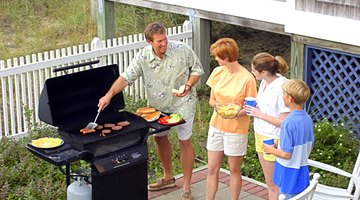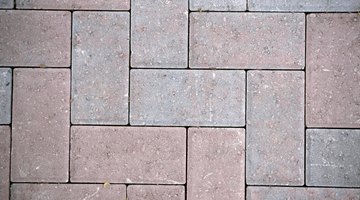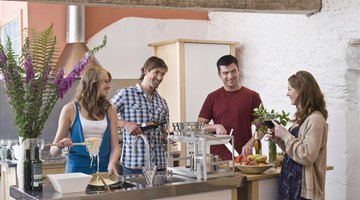How to Design a Barbecue Area
Backyard barbecues have come a long way from the basic, charcoal-burning grill rolled out from the garden shed for an occasional summer cookout. Homeowners living in moderate climates often use their grills year-round, turning barbecue areas into permanent outdoor kitchens.

Elaborate gas grills are surrounded by built-in cabinets, counter space, sinks, extra storage, and often include other appliances such as small refrigerators or wine cooling cabinets. Since the grill itself is the main attraction, the surrounding area should support the function while making sense with the design and form of the grill. A well-designed barbecue area first should factor in safety, followed by function, and end with an aesthetically pleasing outdoor living space, no matter what type of grill is at the center.
-
Measure the overall available space on your patio, deck or yard where you plan to build your barbecue area. Draw a rough sketch of where the grill will be located and fill in the surrounding space with the items you want to include. Use the sketch as a guide to take approximate measurements of the grill space, storage space, food prep space and dining space. Fill in each measurement in the appropriate location of the sketch. Refer back to your barbecue area floor plan as needed while you buy the items and materials needed.
-
Think about the type of barbecue grill you would like, and what will fit in the available space. Consider the type of fuel needed to cook. Adjust the placement of the grill to accommodate gas or electricity running from the house if you are planning a permanent outdoor kitchen. Include storage -- at least six or seven feet away from the heat source -- for an extra propane tank or charcoal for portable grills. Choose a well-ventilated area for gas or charcoal grills. Use an electric grill on a balcony, terrace or screened-in porch.
-
Consider safe flooring materials for the cooking area. Choose heat-resistant materials such as cement, brick, stone or ceramic tile. Use a grill mat or pad when cooking on a wood deck or uneven surface.
-
Install outdoor cabinets built with marine-grade polymers that can withstand direct exposure to UV light, heat and moisture. Protect wood cabinetry with weatherproof materials such as backerboard, which provides a surface to which brick or stone masonry can adhere. Use a composite base under wood-framed cabinetry to prevent mildew and rot.
-
Add the outdoor appliances, such as compact refrigerators, ice bins and coolers, included in your barbecue area floor plan. Include extra features such as a sink and fully stocked outdoor bar or beverage center if space and budget allows. Include adequate storage drawers, bins and shelves for cooking and eating utensils, glassware, cookware and tableware.
-
Build some type of roof structure over your cooking and dining areas to shelter from direct sun and rain. Install lighting for more convenient after-dark entertaining. Include a dining table and plenty of seating options.





Things You Will Need
- Tape measure
- Pen or pencil
- Paper
- Grill
- Fireproof flooring materials
- Outdoor appliances (optional)
- Weatherproof cabinetry and storage (optional)
- Lumber and hardware for roof structure (optional)
- Patio table and chairs (optional)
Tip
If your budget is tight, build your barbecue area in stages, as your budget allows. If you rent a home, you can build or buy a portable outdoor kitchen and take it with you when you move. Your barbecue area design should be consistent with the design of your home and your skill level as a DIY craftsman. Enhance this outdoor living space with potted plants, candle lanterns and fabric upholstery on seating cushions that ties in with the decor inside your home.
Warning
Always read the owner's manual and especially the safety guidelines before using a new grill.
Always light a gas grill with the lid open. Check all connections, pipes, hoses and the tank for damage or leaks before using a grill that has been stored or unused for a few months.
Turn off the gas first, then the controls on a gas grill to burn any gas remaining in the pipe.
Two 20-pound propane tanks are the legal limit for one- or two-family residential properties.
References
Writer Bio
Michelle Radcliff owned a retail home furnishings business for eight years. Radcliff offers decorating advice on her blog, Home Decorating News, is a regular contributor on interior design at LoveToKnow.com and earned certification as an interior decorator from Penn Foster College in 2013.
Photo Credits
- Jupiterimages/Comstock/Getty Images
- Jupiterimages/Comstock/Getty Images
- Jupiterimages/Comstock/Getty Images
- Creatas Images/Creatas/Getty Images
- Hemera Technologies/AbleStock.com/Getty Images
- Jupiterimages/BananaStock/Getty Images
- Jupiterimages/Photos.com/Getty Images
More Articles



